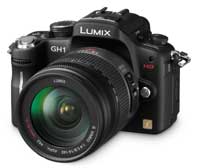Compatible with the Micro Four Thirds System standard, the new Lumix GH1 features advanced video photography functions, such as the ability to record High Definition (HD) AVCHD 1080p/24p video.In addition, the new LUMIX GH1 comes with a newly developed long-zoom interchangeable lens – the Lumix G VARIO HD 14-140mm/F4.0-5.8 ASPH./MEGA O.I.S. This lens was specifically designed to support HD movie recording and features a silent motor and continuous auto focusing (AF) capability; two features which distinguish the LUMIX GH1 from DSLRs that offer HD video recording capabilities.
In late 2008, Panasonic redefined the traditional DSLR category with its launch of the Panasonic Lumix G1 – a digital, interchangeable lens camera system that takes the radical step of eliminating the large, internal mirror structure that is currently contained in all traditional DSLR cameras. This innovation allows for dramatically smaller camera body and lens sizes and permits many new, advanced consumer features such as Lumix G1 “Live View Finder”.
The new Lumix GH1 provides cutting-edge video recording features, including the ability to record high-resolution full HD (1920 x 1080) video at 24 fps or smooth HD video (1280 x 720) movie at 60 fps using an AVCHD format (MPEG-4/H.264). The AVCHD format provides the important benefit of doubling the HD quality recording time compared with Motion JPEG. The Lumix GH1 hosts a dedicated video record button on the back of the camera which lets users instantly start recording videos, even while shooting still photos – removing the fear of potentially missing a must-see video moment. The Lumix GH1 also records video in high-quality stereo sound via Dolby Digital Stereo Creator, the global standard of audio recording. An optional stereo microphone (DMW-MS1) is also available to achieve a more intensive sound recording experience. Finally, a convenient Wind Cut function is provided to help to block out distracting video background noise.
The brilliant 1,440,000-dot equivalent Live View Finder system can also display information settings that a user can see without removing their eyes from the subject. Furthermore, a built-in eye sensor automatically switches on the viewfinder when the user looks into it, then switches it off and turns on the swivel 3.0-inch large 460,000-dot high-resolution LCD when the user looks away from the viewfinder. The 60-frames-per-second Live View is made possible by the Live MOS sensor, which takes real-time signals directly from the image sensor and sends them continuously to the LCD. Both the Live View Finder and LCD provide a 100% field of view – allowing the user to accurately frame and compose a shot from most any position.
The Lumix GH1 kit lens – the Lumix G VARIO HD 14-140mm/F4.0-5.8 ASPH./MEGA O.I.S. –provides a broad focal length range of 28-280mm (35mm camera equivalent) and supports continuous AF using the contrast AF system for both photo and movie capture. The low-noise lens design also seamlessly supports video recording by minimizing the mechanical sound generated by AF/AE actions.
At the core of the Lumix GH1 lies a newly developed 12.1-megapixel high speed Live MOS sensor and Venus Engine HD, which features twin CPUs for outstanding processing capabilities. The Live MOS sensor is capable of high-speed readout over four channels to be compatible with full-HD movie recording. This sensor is also advantageous for photo recording with a high signal-to-noise ratio thanks to the new circuit structure that is unaffected by the noise generated in each of the circuits. This results in crisp photos – even those taken at high ISO levels. The multi-aspect type sensor allows users to take photos in 4:3, 3:2 or 16:9 aspect ratios with the same angle of view. The Venus Engine HD is also energy efficient, supporting long periods of AVCHD video recording on a single battery charge.
In addition to the digital camera’s HD video recording capability, the DMC-GH1 features the Lumix Creative Movie mode which lets the user manually set the shutter speed and aperture, making their videos more creative and representative of their own personal video style preference. Changing the shutter speed gives the videos a special look, particularly suitable for shooting fast-moving subjects. Controlling the aperture is convenient when there are several subjects at varying distances, so the user can focus on the foreground and blur the background – or vice versa.






